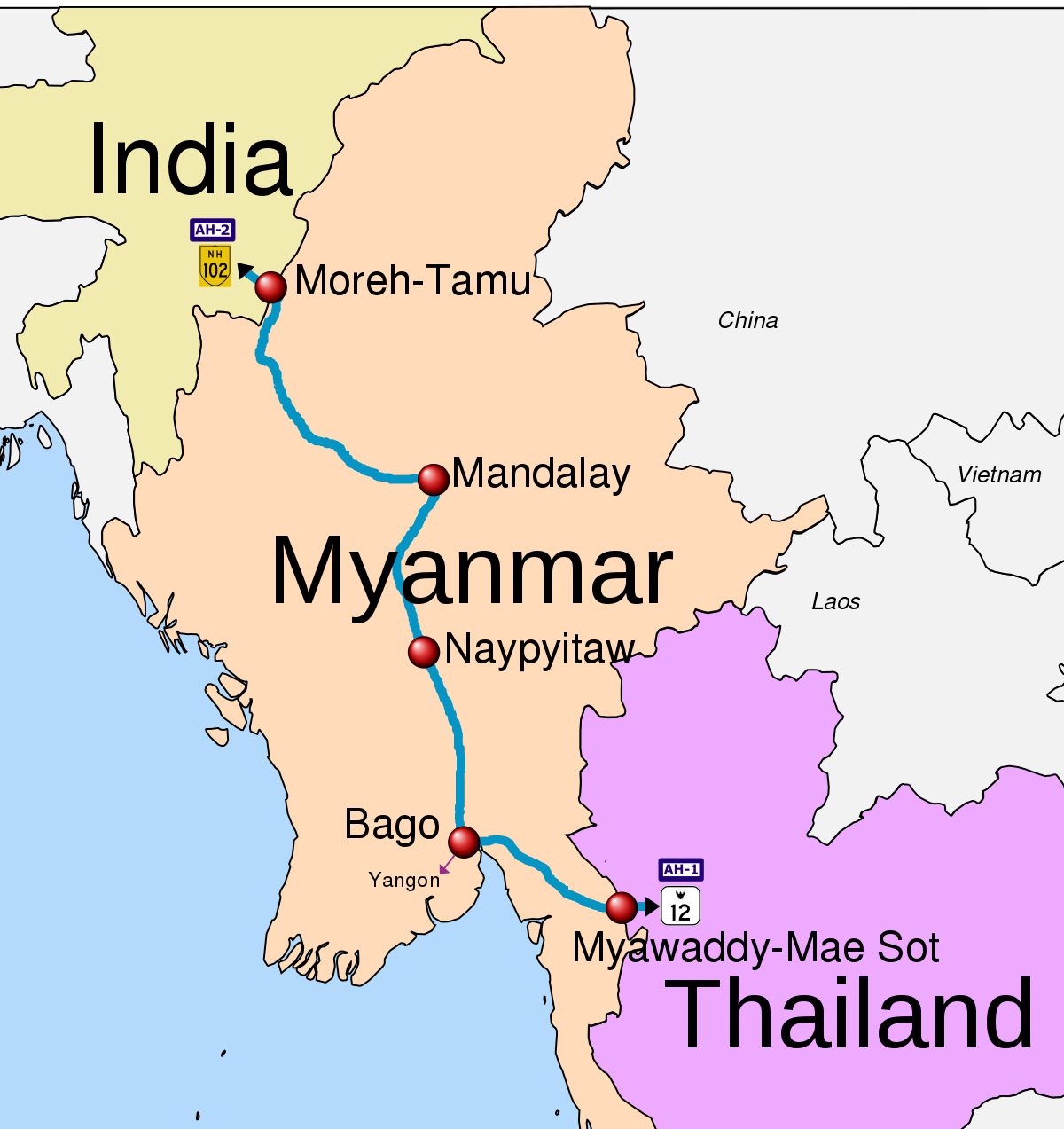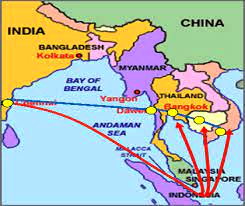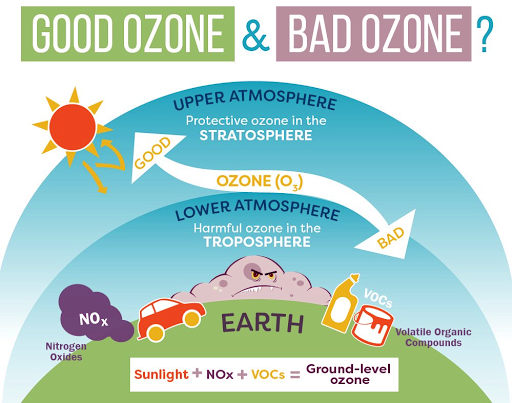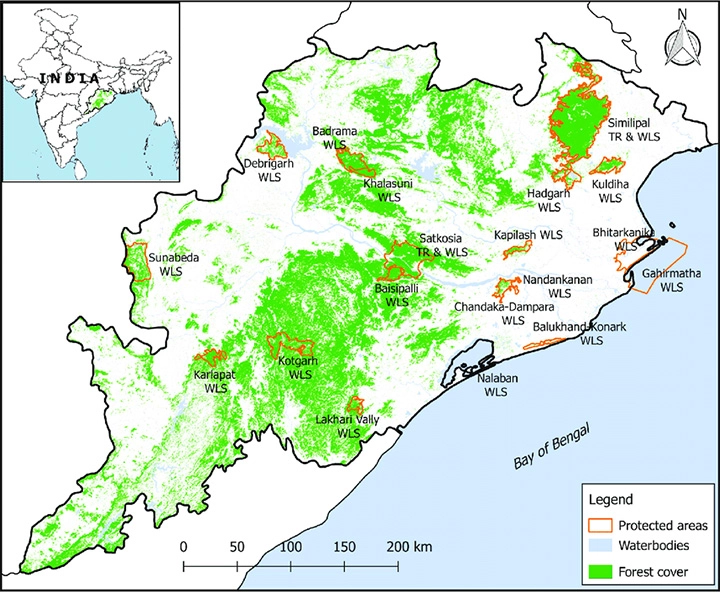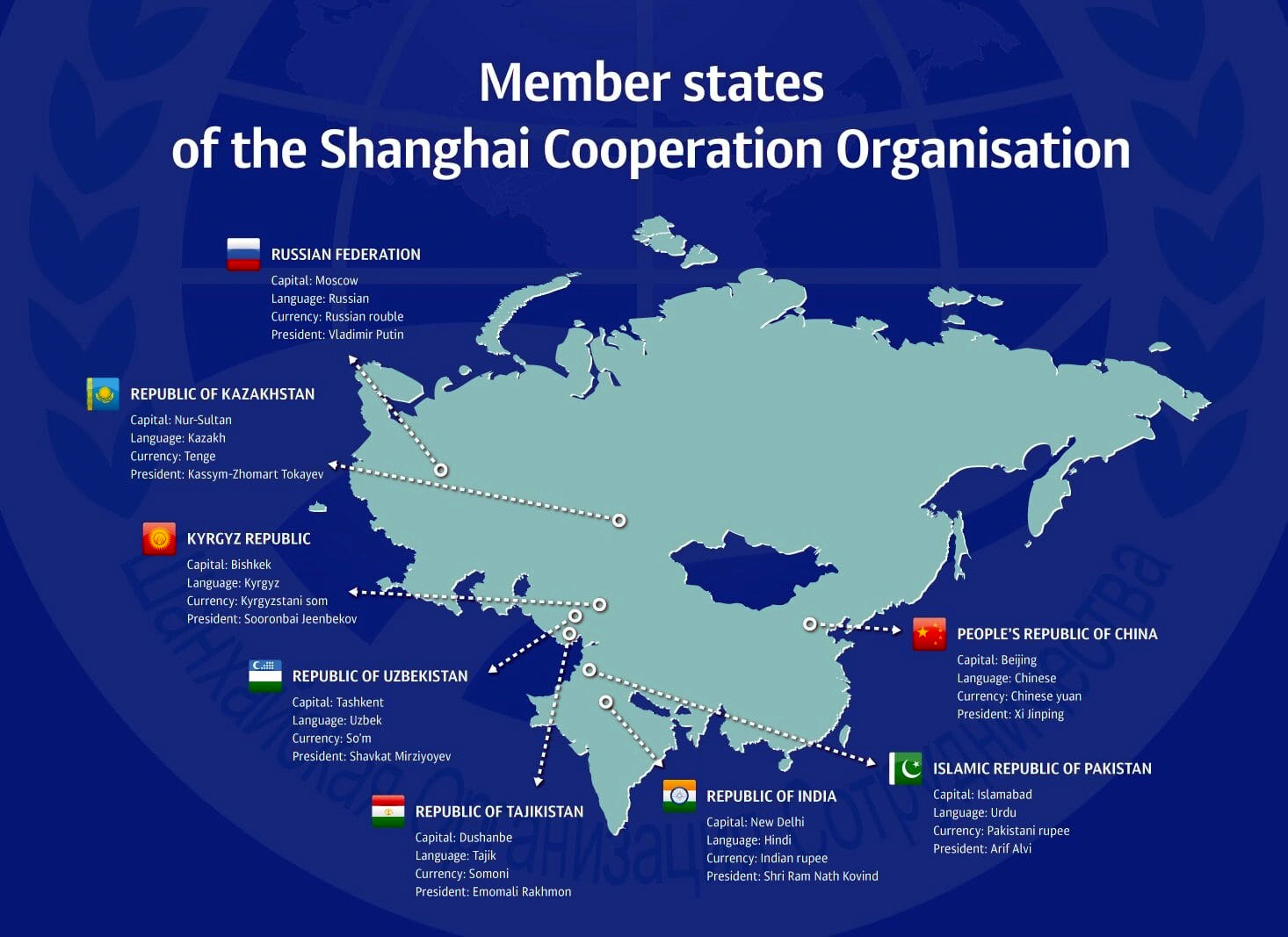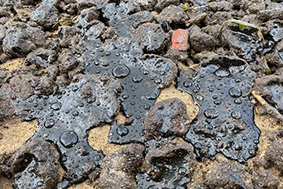Connectivity Projects: India and Southeast Asia
Why in News
Recently, at the virtual ASEAN (Association of Southeast Asian Nations) summit on Future of India-ASEAN Connectivity Partnerships, the Indian government underlined the importance of cross-border connectivity between India and Southeast Asian nations.
- ASEAN brings together ten Southeast Asian states – Brunei, Cambodia, Indonesia, Laos, Malaysia, Myanmar, the Philippines, Singapore, Thailand and Vietnam – into one organisation.
Key Points
- Connectivity between India and Southeast Asia:
- India currently is working with ASEAN on multiple connectivity projects, through land, water, and air.
- Giving substance to ASEAN-India relations through connectivity will gradually change the geopolitical landscape of this region.
- In this context, India has now been actively developing infrastructure in Northeastern India.
- Bangladesh-China-India-Myanmar (BCIM) Corridor is part of this.
- These connectivity projects will not only curb existing insurgencies, but also help India’s northeastern states to develop their economic potential and integrate with mainland India.
- Further, India-ASEAN Free Trade Agreement (FTA) is central to India’s growing engagement with her eastern neighbours.
- It will enable small and medium-sized enterprises in the border areas to explore new business opportunities.
- Examples of Cross Connectivity Projects:
- India-Myanmar-Thailand Trilateral Highway:
- One of the flagship projects for land connectivity between ASEAN and India.
- Connecting the three countries from Moreh in India to Mae Sot in Thailand to Bagan in Myanmar, was first proposed in 2002.
- Besides this, the India, Myanmar, and Thailand Motor Vehicles Agreement (IMT MVA) is in the final stage.
- Kaladan Multi-Modal Transit Transport Project (KMMTTP):
- To develop connectivity through water, ASEAN and India are working on KMMTTP.
- Initiated by the Indian government in 2008 and is entirely funded by India.
- To seek an alternative route through Myanmar for the transportation of goods to the northeast region of India.
- Connects Kolkata in India to Sittwe and Paletwa in Myanmar by sea and river respectively.
- Alongside this initiative, India has contributed to build a sea link via Sittwe port in Myanmar in order to enable an alternative transit route through Bangladesh.
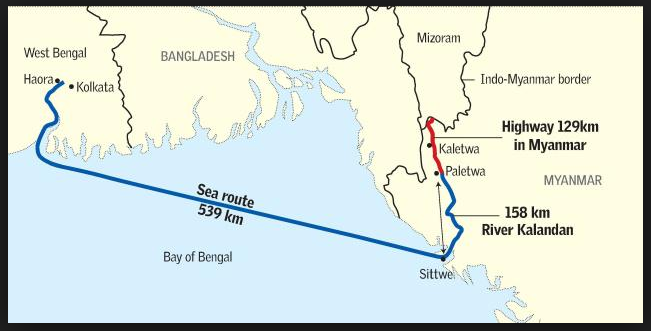
- Mekong-India Economic Corridor (MIEC):
- Involves the integration of four Mekong countries – Vietnam, Myanmar, Thailand, and Cambodia - along with India, connecting Ho Chi Minh City, Dawei, Bangkok, and Phnom Penh with Chennai.
- The corridor will provide opportunities for the participant countries to develop infrastructure, enhance their economic base with the region, and especially reduce the transit distance between India and ASEAN countries.
- India-Myanmar-Thailand Trilateral Highway:
Way Forward
- Extension of Trilateral Highway: The Trilateral Highway can be extended to Cambodia, Laos and Vietnam. This will enable greater connectivity and economic integration of India's northeast with its eastern neighbours.
- Digital Highway: As such beyond movement of goods and physical connectivity, it is also important for two regions to explore ways to enhance digital connectivity.
- This is in concurrence with the Government of India efforts to turn India into a Global Data Hub.
- Improving Maritime Connectivity: With the introduction of the “Sagarmala” project, India plans to invest in port infrastructure for improved integration and connectivity through the sea. This is an encouraging step towards enhancing India-ASEAN Connectivity projects.
No Modification in the Resolution Plan Under IBC: SC
Why in News
Recently, the Supreme Court (SC) held that the Committee of Creditors (CoC) approved resolution plan under the Insolvency and Bankruptcy Code (IBC) submitted to the National Company Law Tribunal (NCLT) cannot be modified.
- Earlier, in July 2021 the government introduced the Insolvency and Bankruptcy Code (Amendment Bill), 2021 in the Lok Sabha.
Key Points
- SC’s Ruling:
- No Modifications: The adjudicating authority cannot allow modifications or withdrawals of Resolution Plans approved by the Committee of Creditors at the behest of the successful Resolution Applicant, once the plan is submitted to it.
- Timely Completion: Corporate Insolvency Resolution Process (CIRP) carried out under the IBC must be completed within 330 days as laid down by the Code.
- It quoted a report of the Parliamentary standing committee on finance which stated that 71% cases are pending for more than 180 days before NCLT (National Company Law Tribunal).
- And asked the NCLT and the National Company Law Appellate Tribunal (NCLAT) to stick to this, and should therefore, while deciding IBC matters, respect the deadline keeping in mind the effect of such delays on the insolvency resolution process.
- Judicial delay was one of the major reasons for the failure of the insolvency regime that was in effect prior to the IBC.
- The time limit can be extended only in exceptional circumstances as otherwise, the open-ended process for further negotiations or a withdrawal, would have a deleterious impact on the Corporate Debtor, its creditors, and the economy at large as the liquidation value depletes with the passage of time.
- Insolvency Resolution Process in India:
- Eligibility: Under IBC, companies (both private and public limited company) and Limited Liability Partnerships (LLP) can be considered as defaulting corporate debtors.
- A corporate debtor is any corporate organization which owes a debt to any person.
- Default Amount: The IBC can be triggered if there is a minimum default of Rs 1 Crore. This process can be triggered by way of filing an application before the NCLT.
- Resolution Initiation: The process can be initiated by two classes of creditors which would include financial creditors and operational creditors.
- Creditors: A Creditor means any person to whom a debt is owed and includes a financial creditor, an operational creditor, etc.
- Financial Creditors: The financial creditor in simple terms is the institution that provided money to the corporate entity in the form of loans, bonds etc. E.g. banks.
- Operational Creditors: An operational creditor is the entity who has a claim for providing any of the four categories to the defaulted corporate- goods, services, employment and Government dues (central govt, state or local bodies).
- Appointment of Interim Resolution Professional: As soon as the matter is admitted by the NCLT, the NCLT proceeds with the appointment of an Interim Resolution Professional (IRP) who takes over the management of the defaulting debtor.
- Committee of Creditors (CoC): A committee consisting only of the financial creditors i.e. the CoC is formed by the IRP.
- Only operational creditors having aggregate dues of at least 10% of the total debt are invited into the meeting of CoC (Operational creditors are not a member of CoC). The operational creditors don’t have any voting power.
- Corporate Insolvency Resolution Process (CIRP): It includes necessary steps to revive the company such as raising fresh funds for operation, looking for a new buyer to sell the company as a going concern, etc.
- The CoC takes a decision regarding the future of the outstanding debt owed to it. The resolution plan can be implemented only if it has been approved by 66% of the creditors in the CoC.
- The IBC (Amendment Bill), 2021 introduced an alternate insolvency resolution process for Micro, Small and Medium Enterprises (MSMEs) with defaults up to Rs 1 crore called the Pre-packaged Insolvency Resolution Process (PIRP).
- Liquidation Proceedings: In the event a resolution plan is not submitted or not approved by the Committee of Creditors (CoC), the CIRP process is deemed to have failed. In such a situation the liquidation proceedings commences subject to the order of the tribunal.
- Eligibility: Under IBC, companies (both private and public limited company) and Limited Liability Partnerships (LLP) can be considered as defaulting corporate debtors.
Way Forward
- Some of the issues faced in the implementation of IBC can be eased by:
- Conducting timely colloquium for judges of NCLT and increasing interaction between practitioners from various jurisdictions.
- NCLTs according to higher priority to applications filed in respect of avoidable transactions such as extortionate, preferential, undervalued, and fraudulent transactions.
- NCLTs discourage frequent adjournments and ensure timeliness of the resolution process.
- Focus should be on sensitizing various government and statutory authorities about the treatment of government and statutory dues under IBC to reduce the scope for litigation and consequent delay in the resolution of companies under corporate insolvency.
Shoonya Campaign: NITI Aayog
Why in News
Recently, NITI Aayog and Rocky Mountain Institute (RMI) and RMI India’s have launched the Shoonya Campaign.
- It is an initiative to promote zero-pollution delivery vehicles by working with consumers and industry.
- RMI is an independent nonprofit organization founded in 1982.
Key Points
- Shoonya Campaign:
- Electric Deliveries: The campaign aims to accelerate adoption of Electric Vehicles (EVs) in the urban deliveries segment and create consumer awareness about the benefits of zero-pollution delivery.
- Shoonya Brand: A corporate branding and certification programme is being launched to recognise and promote industry’s efforts towards transitioning to EVs for final-mile deliveries.
- It will help e-commerce companies to distinguish their offerings from those of their competitors.
- Online Tracking Platform : An online tracking platform will share the campaign’s impact through data such as vehicle kilometers electrified, carbon savings, criteria pollutant savings and other benefits from clean delivery vehicles.
- Need of EVs for Final-Mile Deliveries:
- Growing E-Commerce Market: Between 2013 and 2017, India’s online retail market grew at an average rate of 53% each year and is expected to become a $150 billion market by 2022.
- By shifting the end-transportation of goods from the consumer, this has dramatically expanded the fleets of delivery vehicles.
- Reduce Emissions: Urban freight vehicles account for 10% of freight transportation-related CO2 emissions in India, and these emissions are expected to grow by 114% by 2030.
- EVs emit no tailpipe emissions, which can contribute immensely to an improved air quality.
- Even when accounting for their manufacture, they emit 15-40% less CO2 compared to their internal combustion engine counterparts and have lower operational cost.
- Energy Security: Shifting towards EVs will help India to reduce oil dependency while solving the challenge of energy scarcity and moving towards renewable and clean sources of energy.
- Growing E-Commerce Market: Between 2013 and 2017, India’s online retail market grew at an average rate of 53% each year and is expected to become a $150 billion market by 2022.
- Challenges:
- Technological: India is technologically deficient in the production of electronics that form the backbone of the EV industry, such as batteries, semiconductors, controllers, etc.
- Infrastructural Support: The lack of clarity over AC versus DC charging stations, grid stability and range anxiety (fear that batteries will soon run out of power) are other factors that hinder the growth of the EV industry.
- Availability of Materials for Domestic Production: Battery is the single most important component of EVs. India does not have any known reserves of lithium and cobalt which are required for battery production.
- India is dependent on countries like Japan and China for the import of lithium-ion batteries.
- Lack of Skilled Workers: EVs have higher servicing costs and higher levels of skills is needed for servicing. India lacks dedicated training courses for such skill development.
- Initiatives Taken:
- National Electric Mobility Mission Plan (NEMMP): NEMMP was launched in 2013 with an aim to achieve national fuel security by promoting hybrid and electric vehicles in the country.
- FAME Scheme: The Indian government has created momentum through its Faster Adoption and Manufacturing of (Hybrid &) Electric Vehicles schemes that encourage, and in some segments mandates the adoption of EVs, with a goal of reaching 30% EV penetration by 2030.
- National Mission on Transformative Mobility and Battery Storage: The Mission will recommend and drive the strategies for transformative mobility and phased manufacturing programmes for EVs, EV Components and Batteries.
- Fiscal Incentives: To spur the production and consumption of EVs and charging infrastructure - such as income tax rebates, exemption from customs duties, etc.
Arsenic Contamination of Food Chain
Why in News
A recent study in Bihar has found Arsenic contamination not only in groundwater but in the food chain as well.
- The research study was a part of the Project Nature and Nurture in Arsenic Induced Toxicity of Bihar jointly funded by the British Council in the United Kingdom and Department of Science and Technology in India.
Key Points
- Major Findings:
- Food Chain Contamination:
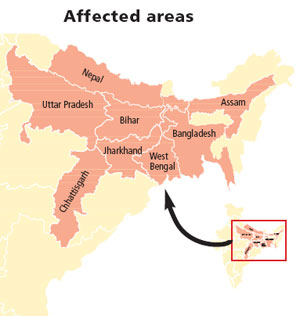
- Arsenic has found its way into the food chain - mainly rice, wheat and potato.
- Arsenic contamination in groundwater has been a growing concern in several parts of the country.
- Arsenic is present in the groundwater as it is used on a large scale for irrigation by farmers. That is how it finds its way into the food chain as well.
- Arsenic has found its way into the food chain - mainly rice, wheat and potato.
- Food vs Water Contamination:
- The food had more arsenic content than drinking water, even when arsenic levels in drinking water was above the World Health Organization (WHO) provisional guide value of 10 micrograms per litre (μg/L).
- The concentration was higher in cooked rice compared to raw rice.
- The food had more arsenic content than drinking water, even when arsenic levels in drinking water was above the World Health Organization (WHO) provisional guide value of 10 micrograms per litre (μg/L).
- Food Chain Contamination:
- Arsenic:
- About:
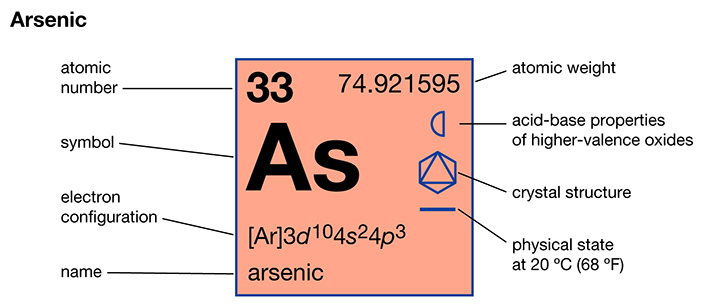
- It is an odourless and tasteless metalloid widely distributed in the earth’s crust.
- It is naturally present at high levels in the earth crust and groundwater of a number of countries. It is highly toxic in its inorganic form.
- Arsenic Poisoning:
- It can get into the human body through drinking water as well as eating food that has been contaminated with arsenic.
- Arsenicosis is the medical word for arsenic poisoning, which occurs due to accumulation of large amounts of arsenic in the body.
- It leads to adverse health effects through inhibition of essential enzymes, which ultimately leads to death from multi-system organ failure.
- Long-term exposure to arsenic from drinking-water and food can cause cancer and skin lesions. It has also been associated with cardiovascular disease and diabetes.
- In utero and early childhood exposure has been linked to negative impacts on cognitive development and increased deaths in young adults.
- Steps Taken: Under the 2030 Agenda for Sustainable Development, the indicator of "safely managed drinking water services" calls for tracking the population accessing drinking water which is free of faecal contamination and priority chemical contaminants, including arsenic.
- Jal Jeevan Mission is envisioned to provide safe and adequate drinking water through individual household tap connections by 2024 to all households in rural India.
- Recently, the Jal Jeevan Mission (Urban) has also been launched.
- About:
Way Forward
- There is an urgent need to monitor irrigation water quality along with drinking water.
- What is required is to make its mitigation a success by involving the public in planning and maintenance, while also giving states the necessary push.
- The remedial measures include a variety of options, ranging from removing arsenic from groundwater after it is extracted, searching alternative aquifers, reducing the level within the aquifer itself, dilution of the contaminants by artificial recharge, blending with potable water etc.
World Ozone Day
Why in News
Every year, 16th September is observed as the International Day for the Preservation of the Ozone layer (World Ozone Day).
Key Points
- About:
- After the Montreal Protocol on Substances that deplete the ozone layer signed by almost every country in 1987, the United Nation General Assembly, in 1994, proclaimed this day as the International Day for the Prevention of the Ozone Layer.
- The Montreal Protocol has led to the phase-out of 99% of ozone-depleting chemicals in refrigerators, air-conditioners and many other products.
- The latest Scientific Assessment of Ozone Depletion completed in 2018, shows that parts of the ozone layer have recovered at a rate of 1-3% per decade since 2000.
- Ozone layer protection efforts have also contributed to the fight against climate change by averting an estimated 135 billion tonnes of carbon dioxide equivalent emissions, from 1990 to 2010.
- In September 2009, the Vienna Convention and the Montreal Protocol became the first treaties in the history of the United Nations to achieve universal ratification.
- Establishment of a mechanism for cooperation to take action to protect the ozone layer was formalized in the Vienna Convention in 1985.
- In 2016 as a continuation of the global effort the Parties to the Montreal Protocol reached agreement at their 28th Meeting of the Parties in Kigali, Rwanda to phase-down hydrofluorocarbons (HFCs).
- Recently, the Indian Government approved the ratification of the Kigali Amendment to the Montreal Protocol.
- After the Montreal Protocol on Substances that deplete the ozone layer signed by almost every country in 1987, the United Nation General Assembly, in 1994, proclaimed this day as the International Day for the Prevention of the Ozone Layer.
- 2021 Theme:
- Montreal Protocol – Keeping us, our food, and vaccines cool.
Ozone
- About:
- It is a special form of oxygen with the chemical formula O3. The oxygen we breathe and that is so vital to life on earth is O2.
- Most ozone resides high up in the atmosphere, between 10 and 40km above Earth's surface. This region is called the stratosphere and it contains about 90% of all the ozone in the atmosphere.
- Classification:
- Good Ozone:
- Ozone occurs naturally in the Earth's upper atmosphere (Stratosphere) where it forms a protective layer that shields us from the sun's harmful ultraviolet rays.
- This “good” ozone is gradually being destroyed by man-made chemicals referred to as Ozone-Depleting Substances (ODS), including chlorofluorocarbons (CFCs), hydrochlorofluorocarbons (HCFCs), halons, methyl bromide, carbon tetrachloride, and methyl chloroform.
- Bad Ozone:
- In the Earth's lower atmosphere (troposphere) near ground level, ozone is formed when pollutants emitted by cars, power plants, industrial boilers, refineries, chemical plants, and other sources react chemically in the presence of sunlight.
- Surface level ozone is a harmful air pollutant.
- In the Earth's lower atmosphere (troposphere) near ground level, ozone is formed when pollutants emitted by cars, power plants, industrial boilers, refineries, chemical plants, and other sources react chemically in the presence of sunlight.
- Good Ozone:
Black Tigers
Why in News
Recently, scientists have unraveled the mystery behind Odisha’s ‘Black Tigers’ in Similipal Tiger Reserve (STR)
- The STR is the only tiger habitat in the world with melanistic tigers, which have broad black stripes running across their bodies and thicker than those seen on normal tigers.
Key Points
- About:
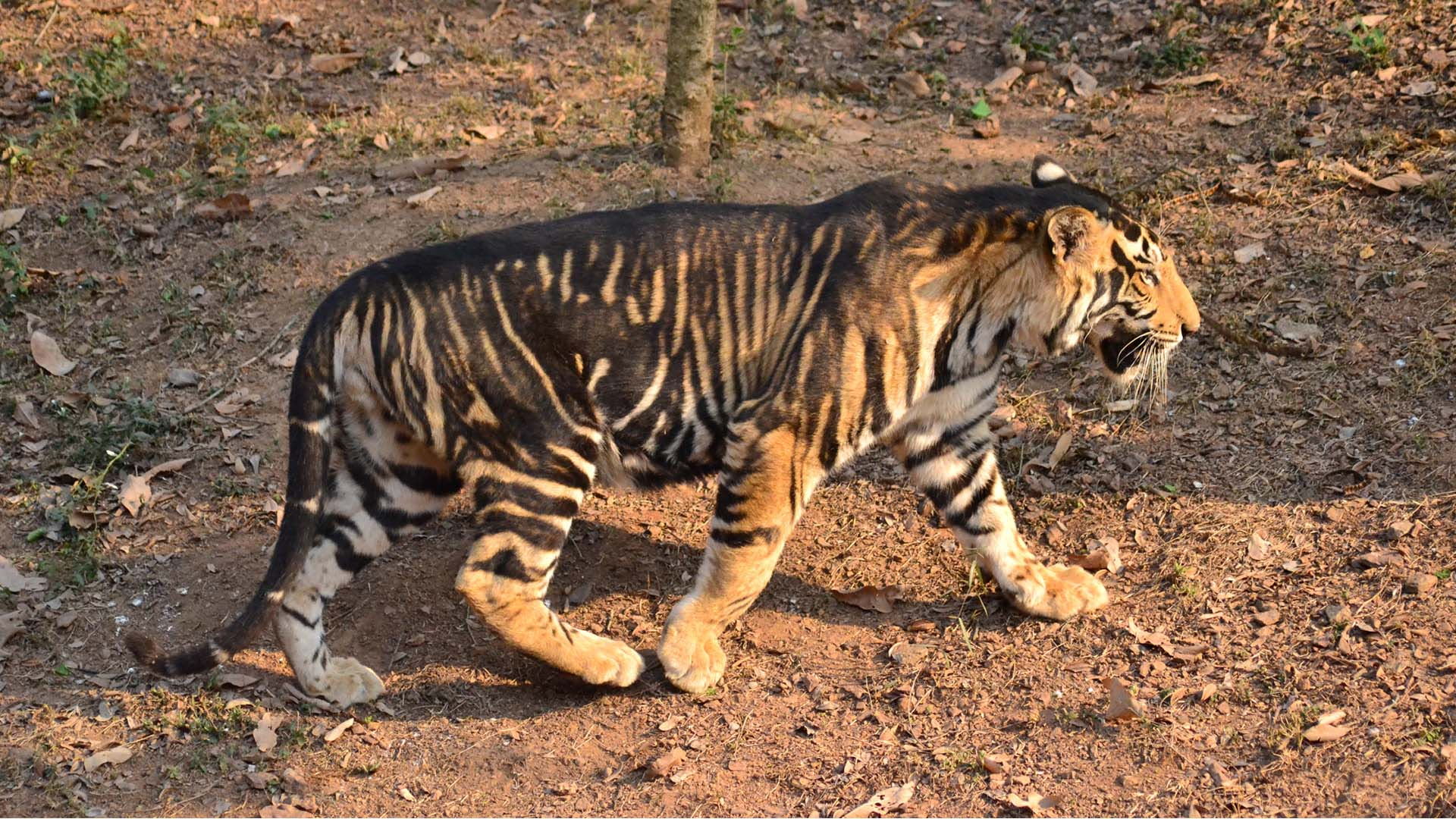
- Black Tigers are a rare colour variant of the tiger and are not a distinct species or geographic subspecies.
- The coat colouration and patterning that make the wild cats appear dark boil down to a single mutation in the Transmembrane Aminopeptidase Q (Taqpep) gene.
- The abnormally dark or black coat in such tigers is termed pseudo melanistic or false coloured.
- If you pick any tiger from Similipal, the chance that it carries the mutant gene is almost 60%.
- Factors for Occuring Black Colour:
- Due to Geographic Isolation, genetically related individuals have been mating with each other for many generations in Similipal, leading to inbreeding.
- It should be noted that this has important implications for tiger conservation as such isolated and inbred populations are prone to extinction over even short periods of time.
- Due to Geographic Isolation, genetically related individuals have been mating with each other for many generations in Similipal, leading to inbreeding.
Similipal Tiger Reserve
- About:
- It was formally designated a tiger reserve in 1956 and brought under Project Tiger in the year 1973. It was declared a biosphere reserve by the Government of India in June, 1994.
- It has been part of the UNESCO World Network of Biosphere Reserve since 2009.
- It is part of the Similipal-Kuldiha-Hadgarh Elephant Reserve popularly known as Mayurbhanj Elephant Reserve, which includes 3 protected areas i.e. Similipal Tiger Reserve, Hadagarh Wildlife sanctuary and Kuldiha wildlife sanctuary.
- Location:
- It is situated in the northern part of Odisha’s Mayurbhanj district. Geographically, it lies in the eastern end of the eastern ghat.
- Wildlife:
- Similipal is home to a wide range of wild animals including tigers and elephants, besides 304 species of birds, 20 species of amphibians and 62 species of reptiles.
- Tribes:
- Two tribes, the Erenga Kharias and the Mankirdias, inhabit the reserve’s forests and practise traditional agricultural activities (the collection of seeds and timber).
- Vulnerability to Forest Fires:
- Natural: Natural causes such as lighting or even soaring temperatures can sometimes result in forest fires here.
- Man Made Factors: Instances of poaching and hunting wherein the poachers set a small patch of forest on fire to divert the wild animals, can lead to forest fires.
- Other Major Protected Areas in Odisha:
- Bhitarkanika National Park.
- Badrama WLS.
- Chilika (Nalaban island) WLS.
- Hadgarh WLS
- Baisipalli WLS.
- Kotagarh WLS.
- Nandankanan WLS.
- Lakhari Valley WLS.
- Gahirmatha (Marine) WLS.
Mu Variant of Covid-19
Why in News
Recently, the World Health Organisation (WHO) has added a new variant of Covid-19 in the list of Variants of Interest (VOI) and named it Mu (B.1.621). It has also added C.1.2 as a new VOI.
- According to INSACOG (Indian SARS-CoV-2 Genomics Consortium), India has so far not seen Mu and C.1.2, and the Delta variant and its sub-lineages continue to be the main Variants of Concern (VOC).
- C.1.2 is a sub-lineage of the C.1 variant described in South Africa but did not spread globally.
Key Points
- About:
- Mu belongs to the lineage B.1.621 variant and named after the twelfth letter of the Greek alphabet. It was first detected in Colombia in January 2021.
- It has a constellation of mutations that indicate potential properties of immune escape. It has several substitutions affecting the Spike Protein and amino acid changes.
- It has seen mutations, E484K, N501Y, P681H, D614G, which have been reported in other VOIs and VOCs.
- It is the fifth ‘VOI’ to be monitored by WHO. The other four VOIs are:
- Eta (lineage B.1.525), Iota (lineage B.1.526), Kappa (lineage B.1.617.1), and Lambda (lineage C.37).
- Variants of Interest:
- A variant is placed in the VOI list if it is seen to have certain “genetic changes that are predicted or known to affect virus characteristics such as transmissibility, disease severity, immune escape, diagnostic or therapeutic escape”.
- To be added to the VOI list, a variant must also be “identified to cause significant community transmission or multiple Covid-19 clusters in multiple countries”, and suggest “an emerging risk to global public health”.
- Variants of Concern:
- A VOI can become a VOC if it is demonstrated to be associated with an increase in transmissibility or virulence, or with a “decrease in effectiveness of public health and social measures or available diagnostics, vaccines, and therapeutics”.
- Currently, four variants of the coronavirus are designated as variants of concern:
- Alpha (lineage B.1.1.7, the so-called ‘UK variant’), Beta (lineage B.1.351, ‘South Africa variant’), Gamma (lineage P.1, ‘Brazil variant’), Delta (lineage B.1.617.2).
Mutation, Variant and Strain
- When a virus replicates it doesn’t always manage to produce an exact copy of itself.
- This means that, over time, the virus may start to differ slightly in terms of its genetic sequence.

- Any changes to the viral genetic sequence during this process is known as a Mutation.
- Viruses with new mutations are sometimes called Variants. Variants can differ by one or multiple mutations.
- When a new variant has different functional properties to the original virus and becomes established in a population, it is sometimes referred to as a New Strain of the virus.
- All strains are variants, but not all variants are strains.
AUKUS Grouping
Why in News
Recently, the US has announced a new trilateral security partnership for the Indo-Pacific, between Australia, the UK and the US (AUKUS).
- The major highlight of this arrangement is the sharing of US nuclear submarine technology to Australia.
Key Points
- Focusing on Indo-Pacific: The security grouping AUKUS will focus on advancing strategic interests in the Indo-Pacific region.
- Though the US has explicitly denied that the grouping is targeted against China, its Indo-pacific orientation makes it an alliance against China’s assertive actions in the South China Sea.
- The three countries alongside Canada and New Zealand already share extensive intelligence through the Five Eyes alliance.
- Transferring Nuclear Submarines to Australia: As part of this initiative, Australia will acquire nuclear-powered submarines with help from the UK and the US.
- This step is significant because the US has only shared nuclear submarine technology once before, and it started in 1958 with Great Britain.
- Nuclear submarines that are quieter than their conventional counterparts but also more capable of being deployed for longer periods and needing to surface less frequently.
- Alongside India’s stated intent to acquire more nuclear-powered submarines, it will amount to a step-change increase in the Quad’s undersea and anti-submarine warfare capabilities.
- Quad is a grouping of India, USA, Australia and Japan.
- Australia is now set to join an elite group of only six countries – India, the US, the UK, France, Russia and China – that operate nuclear-powered submarines. It will also be the only country to have such submarines without having a civilian nuclear power industry.
- Multi-Sectoral Cooperation: AUKUS will also involve a new architecture of meetings and engagements between the three countries, as well as cooperation across emerging technologies (applied AI, quantum technologies and undersea capabilities).
Five Eyes Alliance
- The Five Eyes alliance is an intelligence-sharing arrangement between five English-speaking democracies: the US, UK, Canada, Australia and New Zealand.
- The alliance was created during the Cold War (1946-1991) that was fought between the United States and the Soviet Union, as well as their respective allies.
- The alliance was needed to share sensitive information regarding their adversaries on all possible fronts available.
- It is often described as the world's most successful intelligence alliance.
Exercise SCO Peaceful Mission 2021
Why in News
The 6th edition of Exercise Peaceful Mission is being hosted by Russia in the Orenburg Region of South West Russia from 13th to 25th September 2021.
- India participated for the first time in the 5th edition of the Exercise (2018).
Key Points
- It is a Multilateral and Joint Counter Terrorism Exercise, which is conducted biennially as part of military diplomacy between Shanghai Cooperation Organisation (SCO) member states.
- The SCO is an economic and security bloc in which India and Pakistan were admitted as full members in 2017. Its founding members included China, Russia, Kazakhstan, Kyrgyzstan, Tajikistan and Uzbekistan.
- The scope of the exercise includes professional interaction, mutual understanding of drills & procedures, establishment of joint command & control structures and elimination of terrorist threats.
- The aim is to foster close relations between SCO member states and to enhance abilities of the military leaders to command multi-national military contingents.
- The Indian military contingent comprising an all arms combined force of 200 personnel including 38 personnel from the Indian Air Force is participating in the Exercise 2021.
Tarballs
Why in News
Recently, black oil-emanating balls also called Tarballs were seen, lying on the shore of Mumbai Beach.
Key Points
- About:
- Tarballs are dark-coloured, sticky balls of oil that form when crude oil floats on the ocean surface. They are formed by weathering of crude oil in marine environments.
- Some of the balls are as big as a basketball while others are smaller globules. They are transported from the open sea to the shores by sea currents and waves.
- Most of the time, the presence of several tarballs indicate an oil spill. However, its annual occurrence on the west coast during the monsoon has led marine biologists and experts to demand an investigation in the matter.
- Oil-well blowouts, accidental and deliberate release of bilge and ballast water from ships, river runoff, discharges through municipal sewage and industrial effluents also leads to the formation of tarballs.
- Once tarballs hit the beaches, they may be picked up by hand or by beach-cleaning machinery.
- Concerns:
- Tarballs that travel towards the coast can get stuck to the fishing nets installed in the sea, making it difficult for fishermen to clean.
- In addition, it could affect marine life, especially filter feeders like clams and oysters.
- Tarballs are difficult to break down, and can therefore travel for hundreds of miles in the sea. Tarball pollution is a major concern to the global marine ecosystem.
- Food retrieved from the coastal waters including fish and other sea food might also get contaminated and become a part of the larger food chain harming the health of people.

